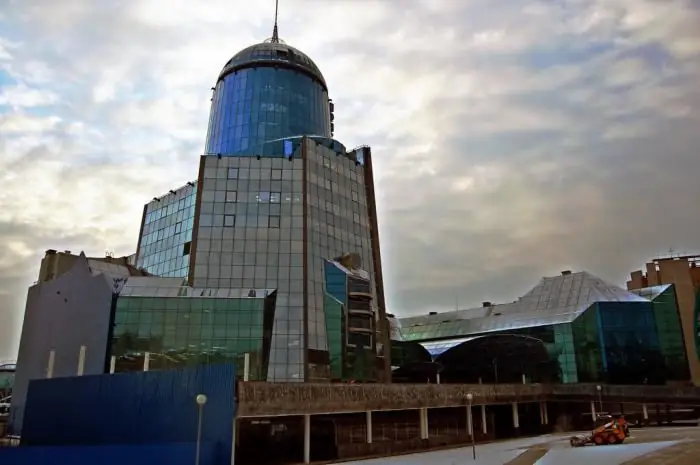- Author Harold Hamphrey [email protected].
- Public 2024-01-07 19:54.
- Last modified 2025-01-24 11:10.
Metro Nevsky Prospekt is part of the St. Petersburg metro line. It is an integral part of the Moscow-Petrograd line. On both sides of which there are points "Gorkovskaya" and "Sennaya Square".
History of Creation
Metro is a quality, fast and convenient way to get to many parts of the city when you need it. The wise construction of the transport complex is an important task, through the implementation of which the daily life of people is greatly simplified.

Nevsky Prospekt is a metro station that opened in 1963 in the summer. Then the zone to which this point belonged was called the "Technological Institute" and passed into the "Petrogradskaya". The name of the station is due to the proximity of the central city highway of the same name. Initially, they wanted to call the Nevsky Prospekt metro station Plekhanov Square, as the territory located near the Kazan Cathedral was previously called.
To get to the station, you need to go down to the underpass, from where there is a path to Mikhailovskaya Street, as well as to the avenue itself. Metro NevskyProspekt (St. Petersburg) was designed by architects Andreev, Shuvalova and Getskin. It was here that a similar model of organizing the part reserved for the lobby was first used.
Reconstructions
When the Nevsky Prospekt metro station was being built, we had to get rid of Perinny Ryads, as well as the Ruska portico. During 1972, the portico was restored, but it acquired slightly different proportions.
Existence of an underground communication for such large cities as St. Petersburg (St. Petersburg) is extremely important. The Nevsky Prospekt metro station quite quickly compensates for this need. Since 2014, Perinny Ryads have been renewed here. It is worth noting that now they are strikingly different from their previous performance.

Old look
When the Nevsky Prospekt metro station was put into operation, it had only one exit, through which communication was carried out between the underground lobby and Mikhailovskaya Street, which is located on the south side.
Outwardly, the exit resembled a cascade, which included two types of escalators: 3 small ones, where you could ride by going into a chamber located across, and 3 large ones, which were part of an inclined passage (a similar structure can be found by going to Proletarskaya”, but here they are at an angle to each other). "Nevsky Prospekt" (Peter) - the metro, undergoing repairs.

Change
During 1998, the inclined course was reconstructed, as a result of which there wasdismantling of small escalators. They were replaced with a flight of stairs, consisting of three flights.
With the onset of the summer season of 2007, we had to get rid of the primary elements that illuminated the lobby and replace them with standard ones. Until November 1967, on the territory of the butt in the north, there was a point for transferring to the Gostiny Dvor station, which was part of the Nevsko-Vasileostrovskaya line. In 1968, on April 30, a passage appeared under the name "Nevsky Prospekt-2". This paragraph summarized two stops. Also, the Nevsky Prospekt metro station was closed for some time due to repair work on the escalators. Then the point just passed non-stop.
What is underground
Going down here, you can find a lot of interesting things. This station is laid at a depth of 63 meters. The underground hall was built by engineer Maksimov and architect Maiofis. The pylons and vaults were decorated with plaster and decoration in the form of aluminum ribs, which were pre-polished.

The walls along the path were tiled with glass, with a red backing, which was replaced in 2006 with artificial stone in a similar color scheme. The floor of the hall in the center was decorated with labradorite and beautiful gabbro. The aprons had an asph alt floor. In 2007, this part was replaced with granite.
In the middle of the room, at a point between two pillars, where the ceiling rises especially high, contains information inscribed in a decree issued on behalf of the Presidium of the USSR Armed Forces. In accordance with it, the Leningrad metro was awarded the Order named after Lenin. During 2004, the administration abandoned lampsbased on mercury and started using sodium illuminators.
Ease of use
Through this point, you can move to trains heading along the Nevsko-Vasileostrovskaya line. This is a unique point in the city where passenger flows are divided along the routes:
- From Nevsky Prospekt to Gostiny Dvor. There is a lift and its own way from the territory of the point. The northern part has a hall where you can descend and ascend. It is removed from the center by several steps. From there, four small electric stairs direct the passenger to the right, to the Gostiny Dvor point. Those who wish to ascend here, others descend further. Thanks to this, the direction in which the passenger flow goes is ensured. From here, on four small escalators, you can get to the left and exit to the Griboedov Canal, which is also connected to Gostiny Dvor by two not very wide corridors that bypass small lifts and are located in parallel. So there are two options for how to bypass this item.
- You can walk from Gostiny Dvor to Nevsky Prospekt. There is a stairway down which you can go to the tunnel for the transition. Usually people move on top of the platform, which has a direction to the north. Going down the stairs, you can find yourself in the hall in the center. The direction of movement of passengers is provided by turnstiles located below.

This is a convenient pick-up point to get you where you need to go.






